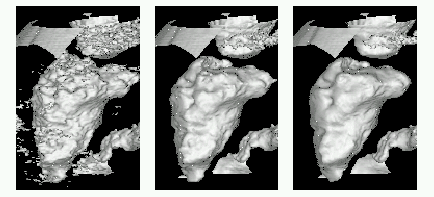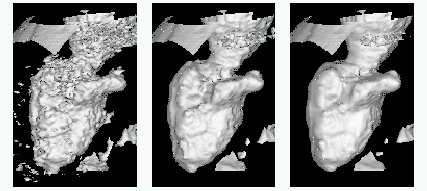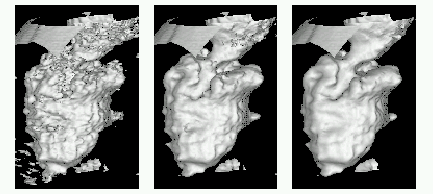Processing of 2D and 3D
Image Sequences
Scaled-space and image enhancement techniques based on parabolic Partial Diffe
rential Equations (PDEs) have proved to be powerful methods in the processing of
two-dimensional (2D) and three-dimensional (3D) images and image sequences. Th
ese models allow to include a-priori knowledge into the
scale-space evolution, and they lead to an image simplification
which simultaneously preserve or even enhance semantically
important information such as edges, lines, or flow-like
structures. Refer to the Sarti-Mikula-Sgallari paper
for the ideas behind the different approaches for image or image sequence
analysis as well as for the introduction of a new PDE model. Purpose of this r
esearch is to analyze numerical schemes for these models for solving PDEs , base
d on semi-implicit approximation in scale, finite-elements and finite volume in
space and to consider the numerical linear algebra aspects involved in the meth
ods and the related linear systems.
Interesting applications of the PDE models for 2D and 3D image analysis have bee
n investigating such as automatic image sequence restoration and image interpola
tion of medical images.
Related publications:
 A.Sarti, K.Mikula,
F.Sgallari, Nonlinear
multiscale analysis of 3D echocardiographic sequences, in IEEE
Transactions on Medical Imaging Vol.18, pp. 453-466, (1999)
A.Sarti, K.Mikula,
F.Sgallari, Nonlinear
multiscale analysis of 3D echocardiographic sequences, in IEEE
Transactions on Medical Imaging Vol.18, pp. 453-466, (1999)
 Morigi, S. Sarti, A. and Sgallari, F.,Parallel multiscale analysis of 2D image sequences, , in Proc. Fifth European SGI/CRAY MPP Workshop, Bologna, Italy, September 99 , (1999)
Morigi, S. Sarti, A. and Sgallari, F.,Parallel multiscale analysis of 2D image sequences, , in Proc. Fifth European SGI/CRAY MPP Workshop, Bologna, Italy, September 99 , (1999)
 Handlovicova, A., Mikula, K. and Sgallari, F.,Numerical methods for nonlinear diffusion equations arising in image processing, submitted(1999)
Handlovicova, A., Mikula, K. and Sgallari, F.,Numerical methods for nonlinear diffusion equations arising in image processing, submitted(1999)



Figures a-c. The multiscale analysis of 1st, 5th and 9th time step of the
echocardiographic sequence. The shape of the left ventricle is extracted in
those moments of cardiac cycle.
 Return to Serena Morigi's Home Page
Return to Serena Morigi's Home Page 



 Return to Serena Morigi's Home Page
Return to Serena Morigi's Home Page